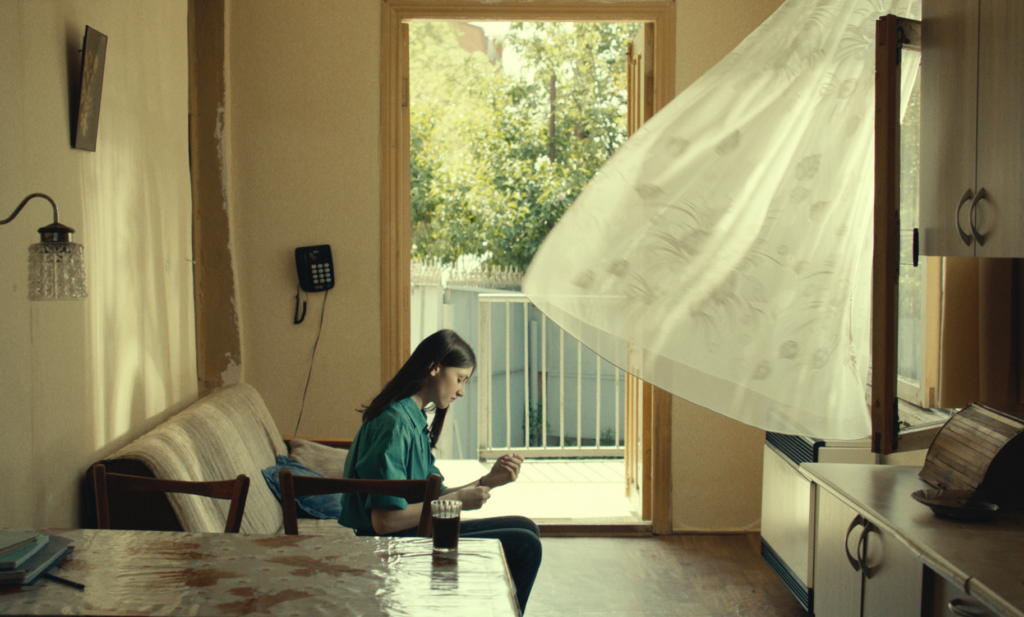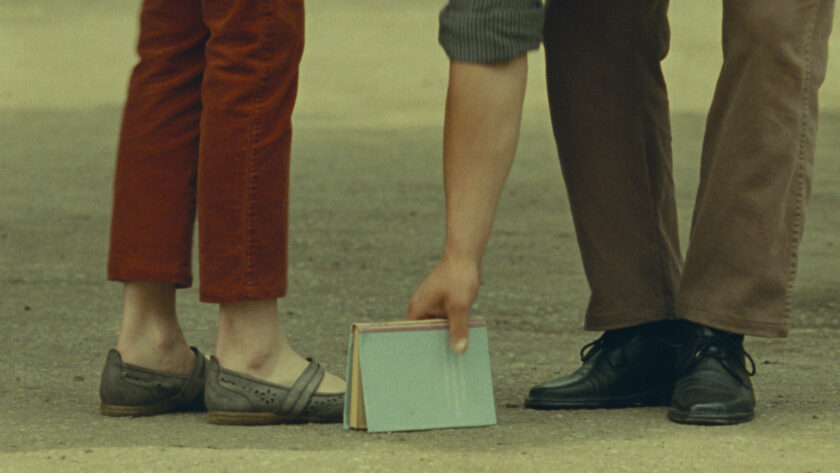Bryn Chiappe evaluates a poetic German-Georgian drama.
Lisa and Georgi bump into each other on the street. We only see their feet and the bottom of their trousers. They meet again and we see them from an immense distance, two miniature figures that one barely registers. The unique nature of these shot choices will, as the film goes on, become characteristic of What Do We See When We Look at the Sky?. On the whole, the film never chooses the safe option with regards to framing, especially during crucial scenes such as these. The first act’s use of a static camera, taking in tableau-like snippets of important moments, imparts a hypnotic atmosphere, reeling one in with exposition that never feels unwelcome or forced. Lisa and Georgi feel immense chemistry, but in their two short meetings, they never exchange names, despite setting up a date. Both wake up to find themselves changed entirely in appearance and having lost the ability to perform their main talent (for Lisa this is a pharmacy, for Georgi it’s football). The pair are uprooted by this development, and attempt to seek each other out despite the obvious hindrances. It’s telling of the film’s supreme confidence and scope that from this premise, the story manages to reach a point in which it is primarily interested in discussing the stray dogs of the city and their individual favourite spots to watch the football world cup.
For a writer-director’s sophomore feature, What Do We See When We Look at the Sky? is an amazingly self-assured project that gives one the rare treat of feeling privy to a talent of truly ground-breaking potential before the crowds have caught wind of it. Within the context of modern filmmaking, it feels troublingly uncommon to come away from a film with a sense that people can still bend the rules and create their own version of how to tell a story. Compounding technological advancements have left film form in a constant state of flux, and rarely does a year go by in which the possibilities for what can be put on screen and how this can be achieved are not stretched to places unimaginable not long before. In terms of arthouse filmmaking, the greatest effect of this has been that of accessibility. In the modern-day, the process of acquiring a camera and editing a film is wildly more straightforward than it has been for the majority of cinema history. However, the ease of access to equipment has been surprisingly lacklustre in translating itself into ease of experimentation with film form and grammar. It was such a joy to see a film that crackled and sparked with the dynamism and disregard for the rulebook that characterised the French New Wave and other similar movements. Koberidze’s approach to storytelling is utterly charming in its playfulness, filled with details that give the viewer a much-needed reminder of the fact that film, like any art form, is not a science. It has conventions and there’s theory to its established grammar, but a director who tethers their poetics to tradition leaves their work at best unambitious, and at worst totally stagnant.

I do not mean to say that the film takes an abstract, hard-to-follow form. Rather, its creativity comes from witty edits and clever narration that maintains its engaging nature through the element of surprise. What might seem a converse point to my enthusiasm about the thrill of filmmaking is the fact that What Do We See When We Look at the Sky? is actually a very slow film. It meanders, veering off on tangents without any sense of urgency about returning to the main plot. In the hands of a less masterful director, this would result in a dull film that is arrogant in its request of one’s attention. In the case of Koberidze, this does not feel to be the case. There are admittedly moments in which one comes to notice that the story hasn’t developed in a major way for several scenes, but this doesn’t come with a sense of frustration or belief that the film is self-indulgent. It takes its central love story at the pace of real day-to-day life, and the focus on seemingly inconsequential details about stories of others in the city of Kutaisi cumulate over its 150 minute runtime to create a touching vision of the richness that can be found in any place, at any time.
The wit of the filmmaking manifests itself in repeatedly breaking one’s ability to suspend their disbelief. The non-mimetic approach is admirable in its embrace of the potential for stylised text appearing on the screen and fourth-wall-breaking narration. My personal favourite example of the approach was a subtitle appearing entirely unexpectedly that instructed the audience to close their eyes when they heard a beep and only open them again when they heard another. Some may dismiss this as a gimmicky, superficial joke, but I found the experience of sitting with my eyes closed and having an acute awareness of the fact that something was continuing to play on the screen before me to be an electrifying moment of clarity with regards to how one can approach a medium that takes place in space and time as the film does. Another memorable instance of being dragged back into the position of ‘film viewer’ when the story became too immersive is the narration at the end of the film, in which the director lists a string of plot holes and criticisms that he expects to receive. There’s no rebuttal after this. He just goes on talking about other things and then the film ends. Like so many other elements of Koberidze’s film, it’s really funny, whilst serving an incredibly powerful function for the storytelling framework that the director is operating in. By pushing the audience away from the central couple through deviations in plot, and reminding them of their status as an audience watching a fictional film, the perspective one ends up finding themselves in is an unfamiliar one for a love story. We retain a strong emotional attachment to the leading characters throughout, but are able to situate them within a wider context that puts life as the object of our affection, rather than just two people. Where most romantic films fall short in centring their entire focus onto two characters who one leaves behind in the cinema, What Do We See When We Look at the Sky? instead creates a bond between the couple and the viewer before reframing their story as one of the many that occur around us all the time. The film finishes, but the world feels warmer and more exciting. The story isn’t left in the cinema because it continues to be around you everywhere, and for a while at least, you notice that fact.




